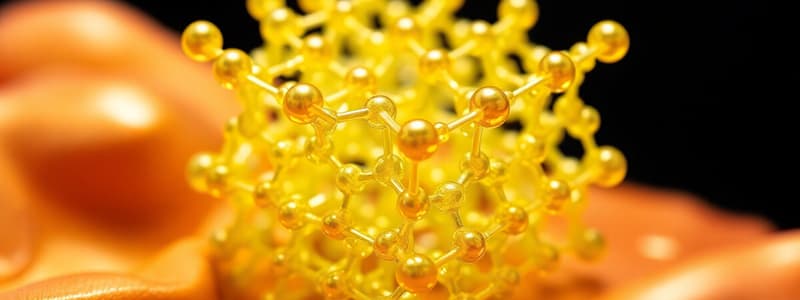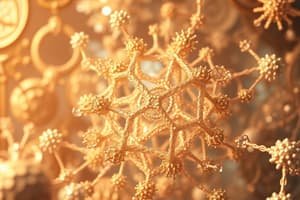Podcast
Questions and Answers
What are the two main types of nanomaterial fabrication methods?
What are the two main types of nanomaterial fabrication methods?
- Top-down and bottom-up (correct)
- Inert gas condensation and sputtering
- Physical and chemical
- CVD and reactive sputtering
High energy ball milling is a chemical method for nanomaterial fabrication.
High energy ball milling is a chemical method for nanomaterial fabrication.
False (B)
Which of the following is NOT a physical method for nanomaterial fabrication?
Which of the following is NOT a physical method for nanomaterial fabrication?
- Arc discharge
- Chemical vapor deposition (correct)
- Laser ablation
- High energy ball milling
What is the primary purpose of using an inert gas in inert gas condensation?
What is the primary purpose of using an inert gas in inert gas condensation?
Ion sputtering is a method used to create thin films by depositing nanoparticles onto a substrate.
Ion sputtering is a method used to create thin films by depositing nanoparticles onto a substrate.
What is the key advantage of using RF sputtering for fabricating materials?
What is the key advantage of using RF sputtering for fabricating materials?
What is the primary purpose of using a reactive gas in reactive sputtering?
What is the primary purpose of using a reactive gas in reactive sputtering?
Which of the following is NOT an advantage of ion sputtering?
Which of the following is NOT an advantage of ion sputtering?
What is the primary purpose of a CVD reactor in the chemical vapor deposition process?
What is the primary purpose of a CVD reactor in the chemical vapor deposition process?
CVD is a widely used technique in the production of high-purity, high-performance coatings.
CVD is a widely used technique in the production of high-purity, high-performance coatings.
What is the primary function of mass flow controllers in the CVD process?
What is the primary function of mass flow controllers in the CVD process?
What is the primary source of energy for the chemical reactions in the CVD process?
What is the primary source of energy for the chemical reactions in the CVD process?
The by-products produced during the CVD process are always removed from the reaction chamber.
The by-products produced during the CVD process are always removed from the reaction chamber.
Flashcards
Inert Gas Condensation (IGC)
Inert Gas Condensation (IGC)
A method of creating nanoparticles by evaporating material in a vacuum and then cooling it with an inert gas.
Inert Gas Introduction (IGC)
Inert Gas Introduction (IGC)
The controlled introduction an inert gas to a heated material in a vacuum chamber to create nanoparticles.
Nucleation (IGC)
Nucleation (IGC)
Small nuclei formed by the cooling and clustering of atoms during inert gas condensation.
Growth (IGC)
Growth (IGC)
Signup and view all the flashcards
Collection (IGC)
Collection (IGC)
Signup and view all the flashcards
Ion Sputtering
Ion Sputtering
Signup and view all the flashcards
Ion Generation (Ion Sputtering)
Ion Generation (Ion Sputtering)
Signup and view all the flashcards
Ion Bombardment (Ion Sputtering)
Ion Bombardment (Ion Sputtering)
Signup and view all the flashcards
Ejection of Atoms (Ion Sputtering)
Ejection of Atoms (Ion Sputtering)
Signup and view all the flashcards
Deposition of Nanostructures (Ion Sputtering)
Deposition of Nanostructures (Ion Sputtering)
Signup and view all the flashcards
Sputter Yield
Sputter Yield
Signup and view all the flashcards
RF Sputtering
RF Sputtering
Signup and view all the flashcards
DC Sputtering
DC Sputtering
Signup and view all the flashcards
Magnetron Sputtering
Magnetron Sputtering
Signup and view all the flashcards
Reactive Sputtering
Reactive Sputtering
Signup and view all the flashcards
Chemical Vapor Deposition (CVD)
Chemical Vapor Deposition (CVD)
Signup and view all the flashcards
Precursors (CVD)
Precursors (CVD)
Signup and view all the flashcards
Reaction Chamber (CVD)
Reaction Chamber (CVD)
Signup and view all the flashcards
Substrate (CVD)
Substrate (CVD)
Signup and view all the flashcards
Precursor Gas Transport (CVD)
Precursor Gas Transport (CVD)
Signup and view all the flashcards
Gas Phase Reactions (CVD)
Gas Phase Reactions (CVD)
Signup and view all the flashcards
Surface Adsorption (CVD)
Surface Adsorption (CVD)
Signup and view all the flashcards
Surface Chemical Reactions (CVD)
Surface Chemical Reactions (CVD)
Signup and view all the flashcards
Nucleation and Film Growth (CVD)
Nucleation and Film Growth (CVD)
Signup and view all the flashcards
Desorption of By-Products (CVD)
Desorption of By-Products (CVD)
Signup and view all the flashcards
Gas Phase Exhaust (CVD)
Gas Phase Exhaust (CVD)
Signup and view all the flashcards
Study Notes
Chapter 2: Formation of Nanostructures, Section B
- Nanomaterial fabrication methods include top-down and bottom-up approaches
- Bottom-up Approach
- Physical Methods:
- High-energy ball milling
- Arc discharge
- Laser ablation
- Inert gas condensation
- Ion sputtering
- Chemical Methods:
- Chemical Vapor Deposition (CVD)
- Self-assembly
- Physical Methods:
- Top-down Approach
Learning Outcomes
- Understand and explain the working principles of key fabrication methods, including ion-gas condensation, ion sputtering, and chemical vapor deposition
- Assess the advantages and disadvantages of these fabrication methods
4. Inert-gas Condensation
-
Inert gas condensation (IGC) is a method for making nanoparticles by evaporating a material (metal or ceramic) in a vacuum, then cooling it with an inert gas (argon or helium)
-
Evaporation of Material: Bulk source material (metal, ceramic, or alloy) is heated and evaporated in a vacuum chamber using methods like resistive heating, electron beam, or laser ablation. Vacuum environment minimizes contamination and vaporizes into free atoms/molecules
-
Inert Gas Introduction: An inert gas (argon or helium) is introduced at a controlled pressure acting as a non-reactive cooling medium. Collisions between vaporized atoms and gas reduce kinetic energy, allowing atoms to slow down and move closer together
-
Nucleation and Growth: As atoms cool, they cluster to form small nuclei that grow into nanoparticles. Size and distribution influenced by factors such as gas pressure, evaporation rate, and temperature
-
Collection on Cooled Substrate: Nanoparticles are transported by the inert gas to a cold substrate (liquid nitrogen or helium). Surface captures particles, preventing re-evaporation, resulting in uniform deposition
-
Additional Information: Multiple crucibles can be used. O2 or N2 gases can be added to the inert gas for forming oxides and nitrides.
-
Key Advantages:
- Size control: Evaporation rate, gas pressure, and condensation time allow for controlled nanoparticle size
- High Purity: Minimal atmospheric contamination leads to highly pure nanoparticles
- Multiple sources
-
Applications:
- Catalysis (high surface area)
- Materials science (research and development of new materials, nanocomposites, and nanostructured coatings)
5. Ion Sputtering
- Ion sputtering is a physical process to eject atoms/molecules from a solid target material by bombarding it with high-energy ions
- Working Principle:
- Ion Generation: An ion source (argon ions – Ar+) is generated in a high-vacuum chamber and accelerated using an electric field to achieve high velocities
- Ion Bombardment: Ions are directed toward the target material (solid sample) at high energies. Upon impact, they transfer momentum and kinetic energy to surface atoms.
- Ejection of Atoms: Collisions beneath the target's surface create a cascade. If energy transferred is higher than surface binding energy, surface atoms are ejected resulting in sputtering. Multiple ejected atoms can leave the surface as neutral atoms, ions, or clusters.
- Deposition of Nanostructures: Ejected atoms can be collected onto a substrate for thin film deposition. The deposited samples can then be analyzed.
- Sputter Yield: Measured by the number of atoms ejected per incident ion. Factors influencing yield include ion energy, incidence angle, target material, ion species, and pressure.
- Types of Ion Sputtering: Different techniques, such as RF sputtering, DC sputtering, magnetron sputtering, and reactive sputtering, use various methods (e.g., radio frequency, direct current, magnetic fields, and reactive gas introduction) for unique applications.
5. CVD
- Chemical Vapor Deposition (CVD) is a process for producing thin films and nanomaterials onto a substrate via precursor chemical reactions
- Process Overview: Precursors (reactant gases or vapors) are introduced into a reaction chamber where they decompose or react on the heated substrate. This results in a thin solid layer formation
- Equipment:
- Chemical vapor precursor supply system (reactant gases)
- CVD reactors
- Gas handling system (for waste gases).
- Key components in the CVD mechanism include
- Precursor Gas Transport: Gases/vapors are introduced into the reaction chamber using mass flow controllers. Flow rate, composition, and ratio are carefully controlled for uniform deposition
- Gas Phase Reactions: Precursor gases decompose in the gas phase as they are transported towards the heated substrate. This step might produce intermediate species or byproducts, depending on the specific CVD process
- Surface Adsorption: Reactive species (atoms, molecules, or radicals) adsorb onto the substrate; adsorption influenced by substrate temperature, surface energy, and reactant concentration, for example
- Surface Chemical Reactions: Adsorbed species undergo reactions, resulting in solid film formation; the reaction can involve decomposition, reduction, or oxidation depending on the target material
- Nucleation & Film Growth: Starting with small atom/molecule clusters which grow until a continuous film is formed
- Desorption of By-products: By-products from surface reactions are removed through the reactor, for example, H2, CO2
- Gas Phase Exhaust: Residual gases, unreacted precursors, and by-products are removed from the reaction chamber
- Applications: Semiconductor manufacturing, nanotechnology, and material science for high-purity, high-performance coatings
Studying That Suits You
Use AI to generate personalized quizzes and flashcards to suit your learning preferences.




